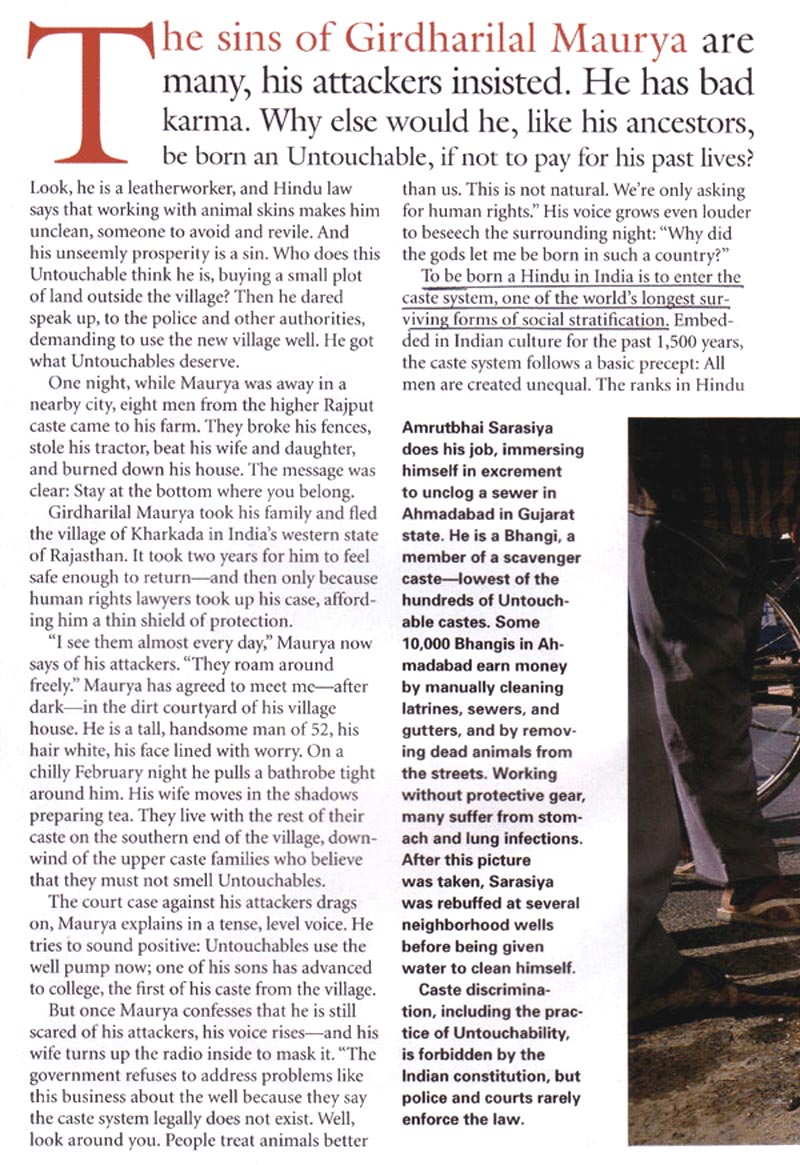
THE HINDU CASTE SYSTEM
Romans 2:11 For there is no partiality with God.

Deuteronomy 10:17 "For the LORD your God is God of gods and Lord of lords, the great God, mighty and awesome, who shows no partiality nor takes a bribe."
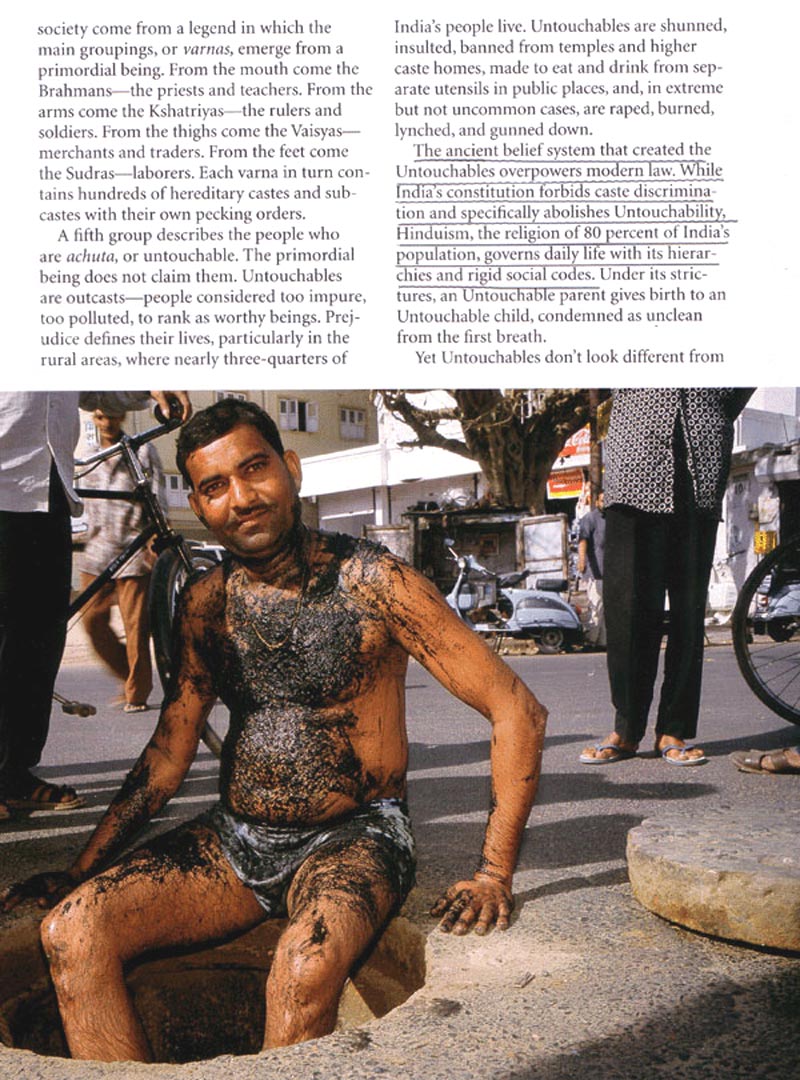
Deuteronomy 16:19 "You shall not pervert justice; you shall not show partiality, nor take a bribe, for a bribe blinds the eyes of the wise and twists the words of the righteous."
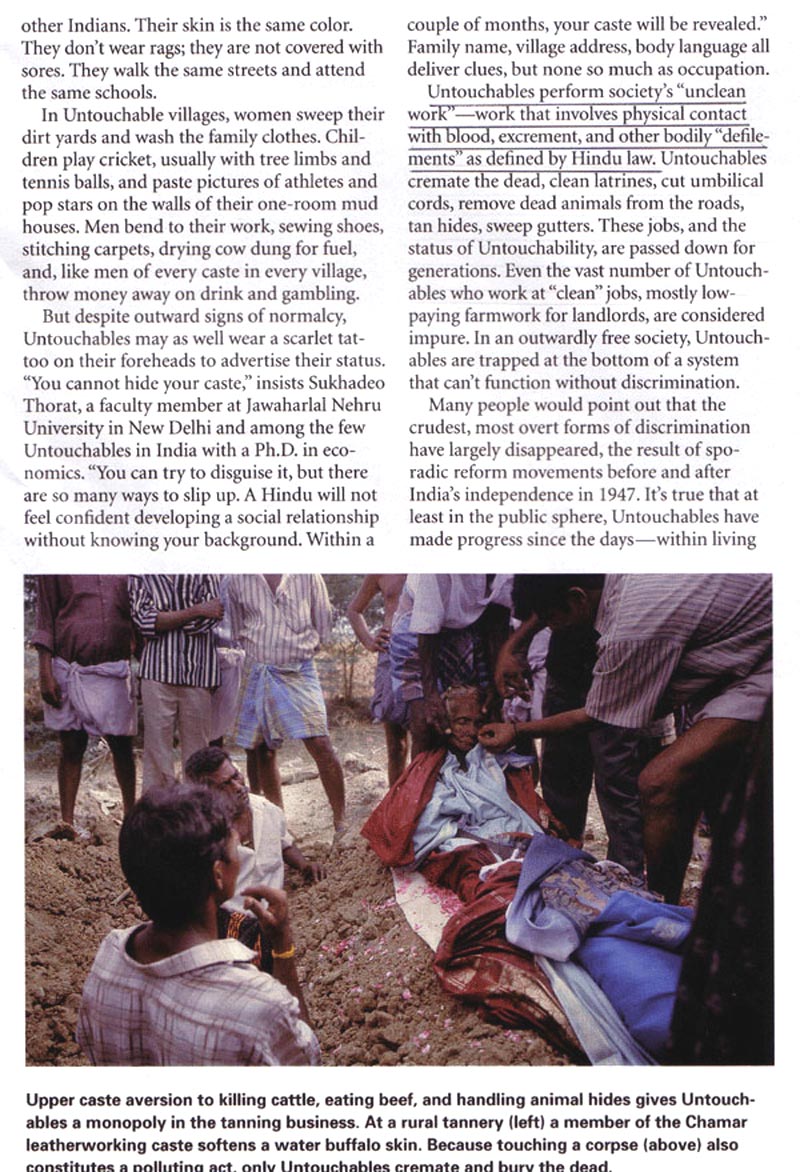
Proverbs 24:23 These things also belong to the wise: It is not good to show partiality in judgment.
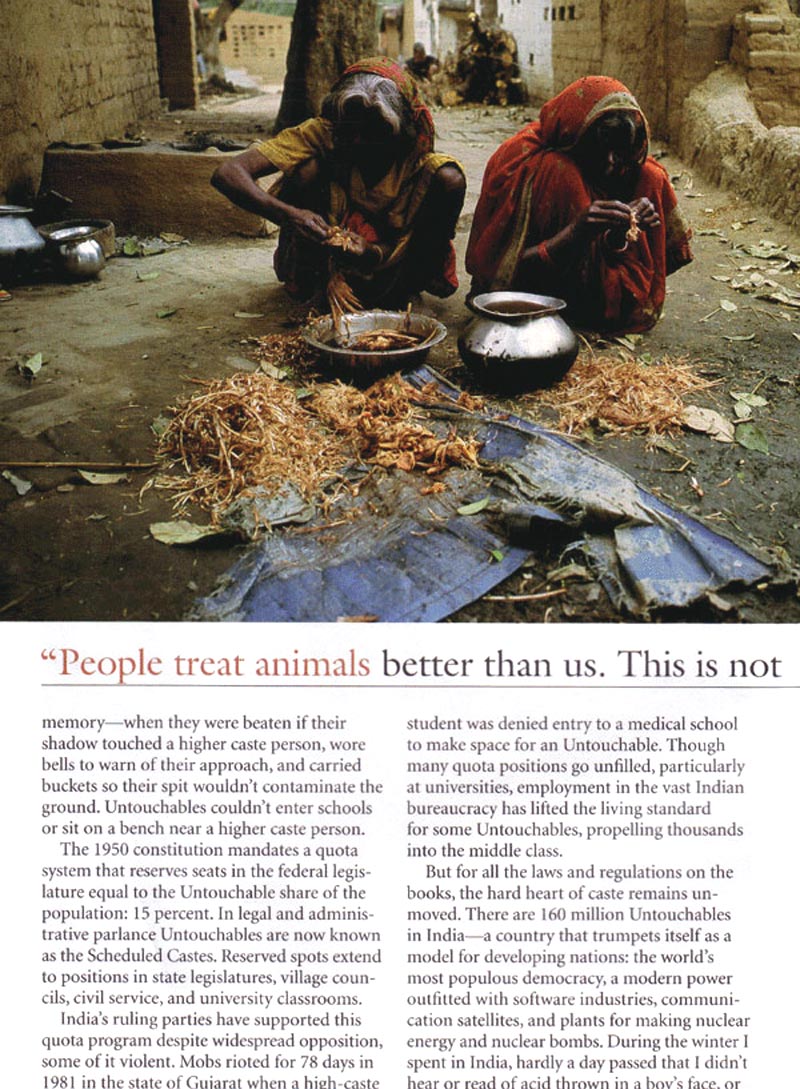
Acts 10:34 Then Peter opened his mouth and said: "In truth I perceive that God shows no partiality."
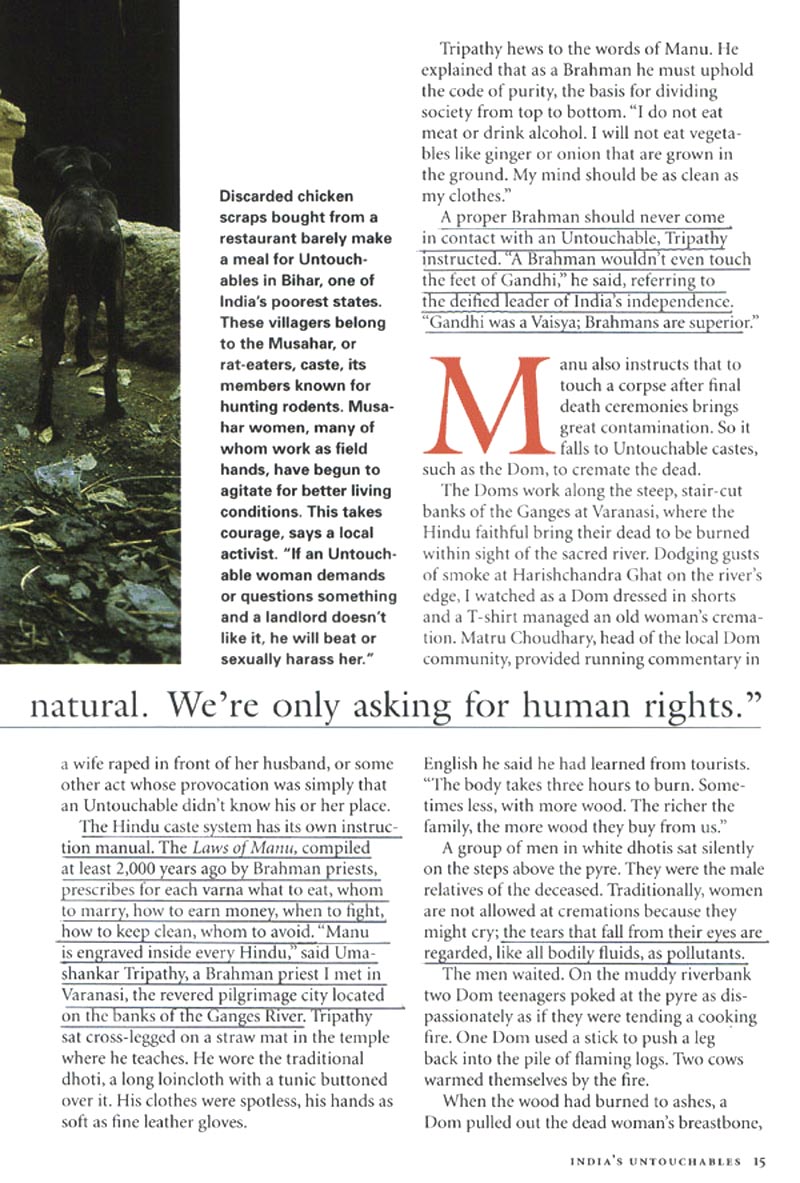
Ephesians 6:9 And you, masters, do the same things to them, giving up threatening, knowing that your own Master also is in heaven, and there is no partiality with Him.
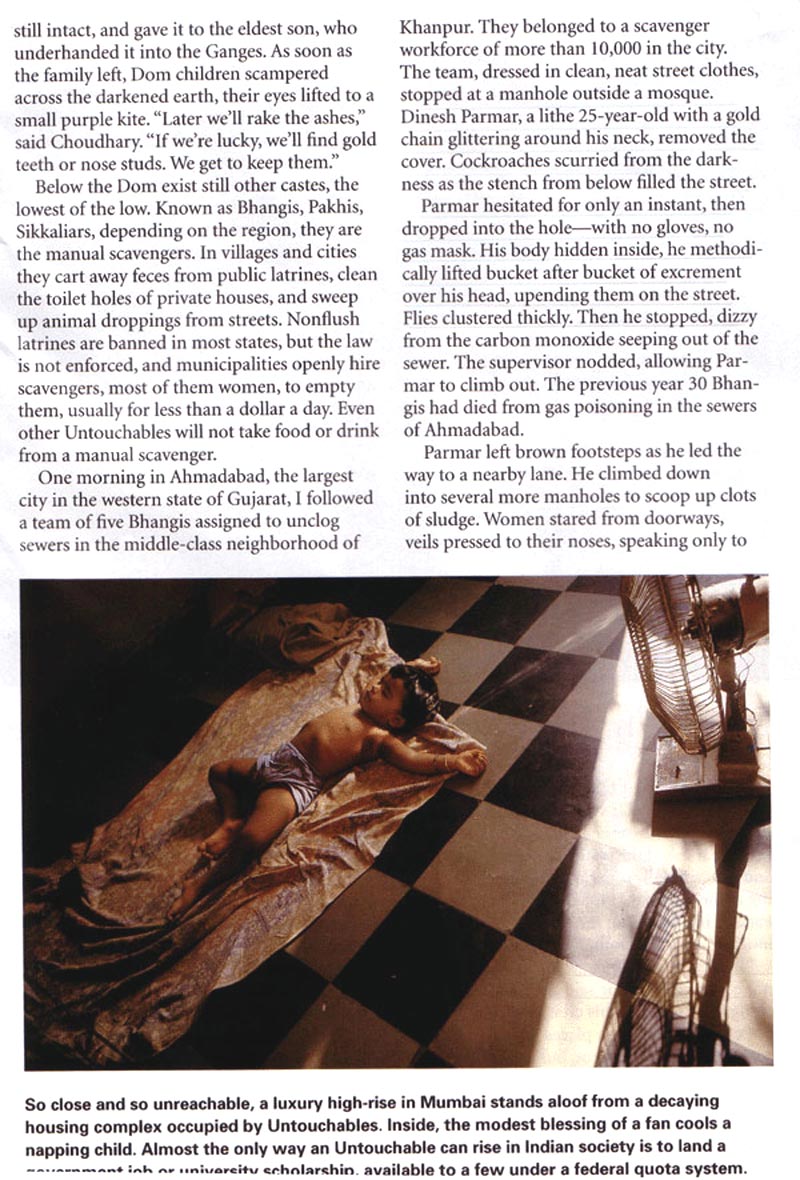
Colossians 3:25 But he who does wrong will be repaid for what he has done, and there is no partiality.
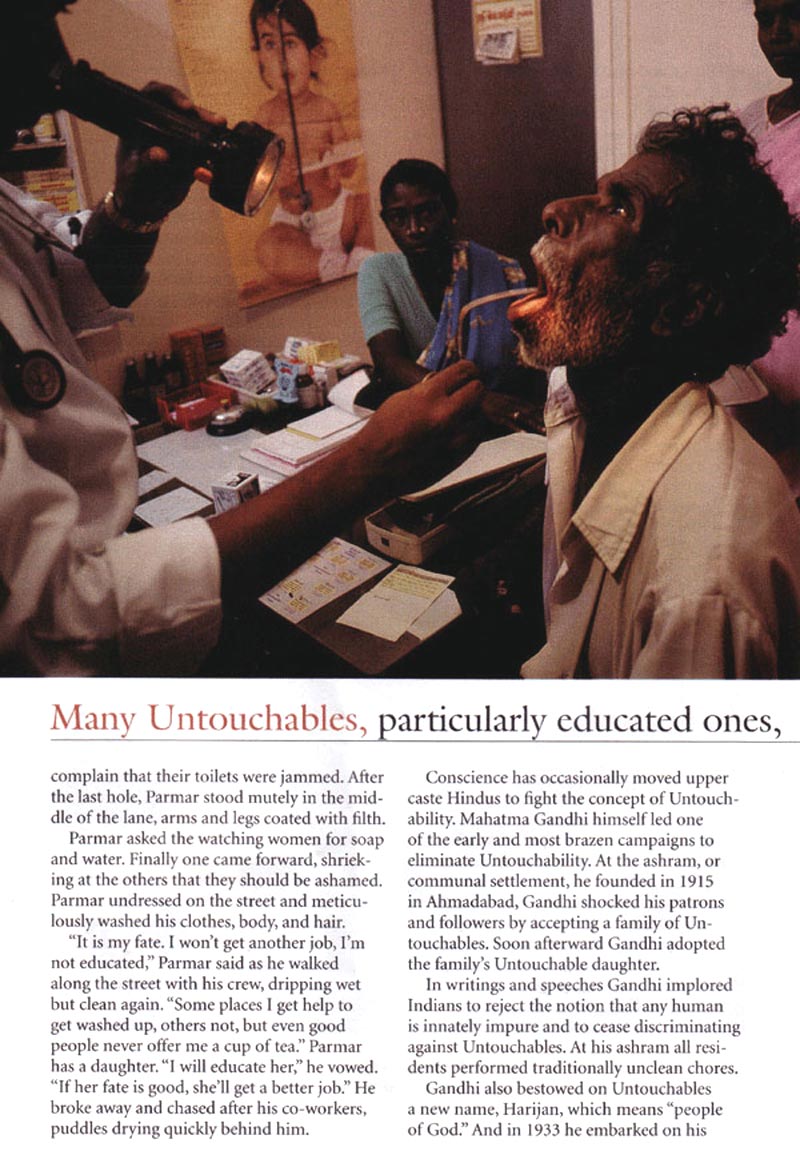
1 Timothy 5:21 I charge you before God and the Lord Jesus Christ and the elect angels that you observe these things without prejudice, doing nothing with partiality.
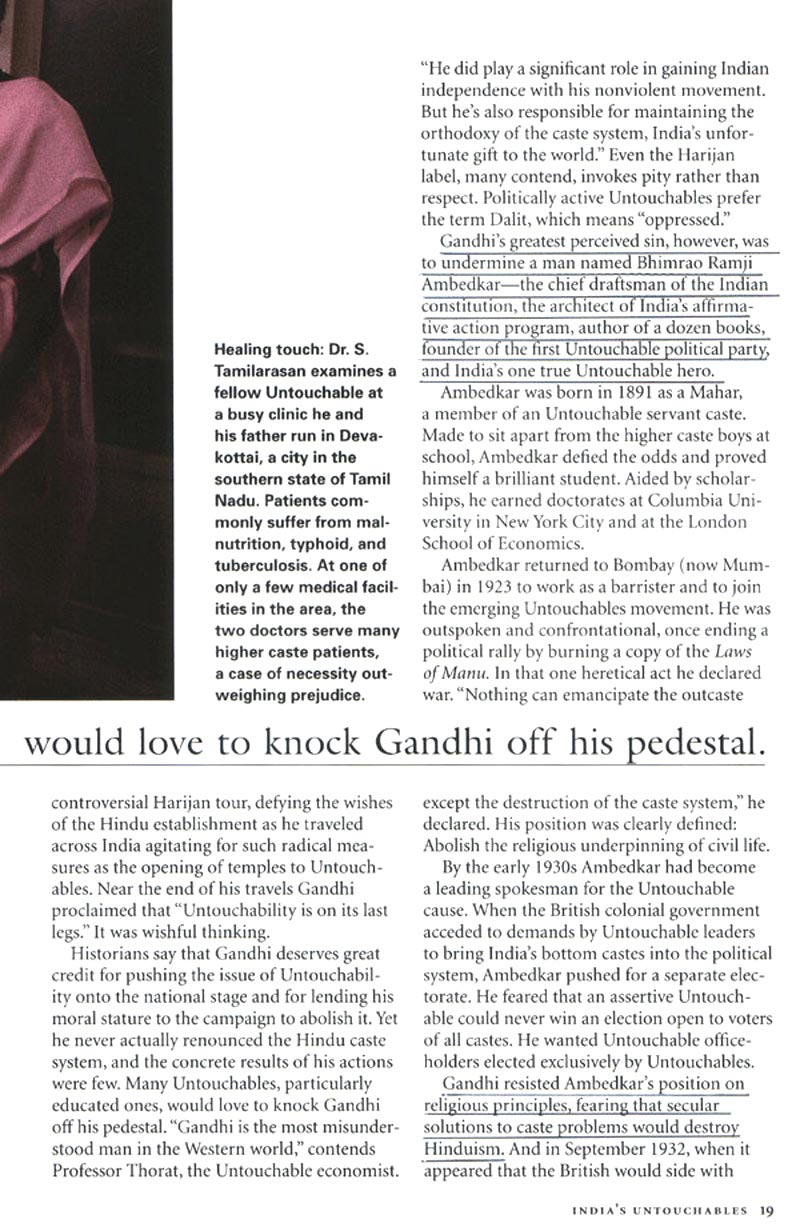
James 2:1 My brethren, do not hold the faith of our Lord Jesus Christ, the Lord of glory, with partiality.
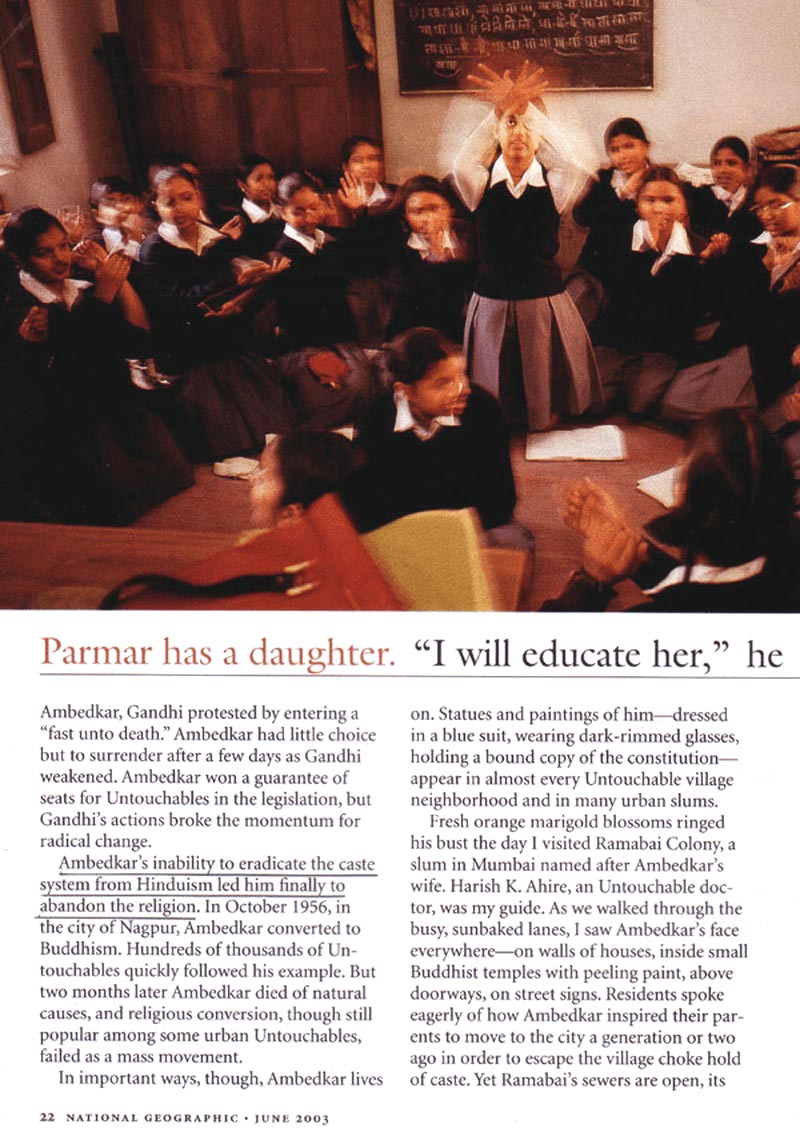
James 2:8-9 If you really fulfill the royal law according to the Scripture, "You shall love your neighbor as yourself," you do well; but if you show partiality, you commit sin, and are convicted by the law as transgressors.
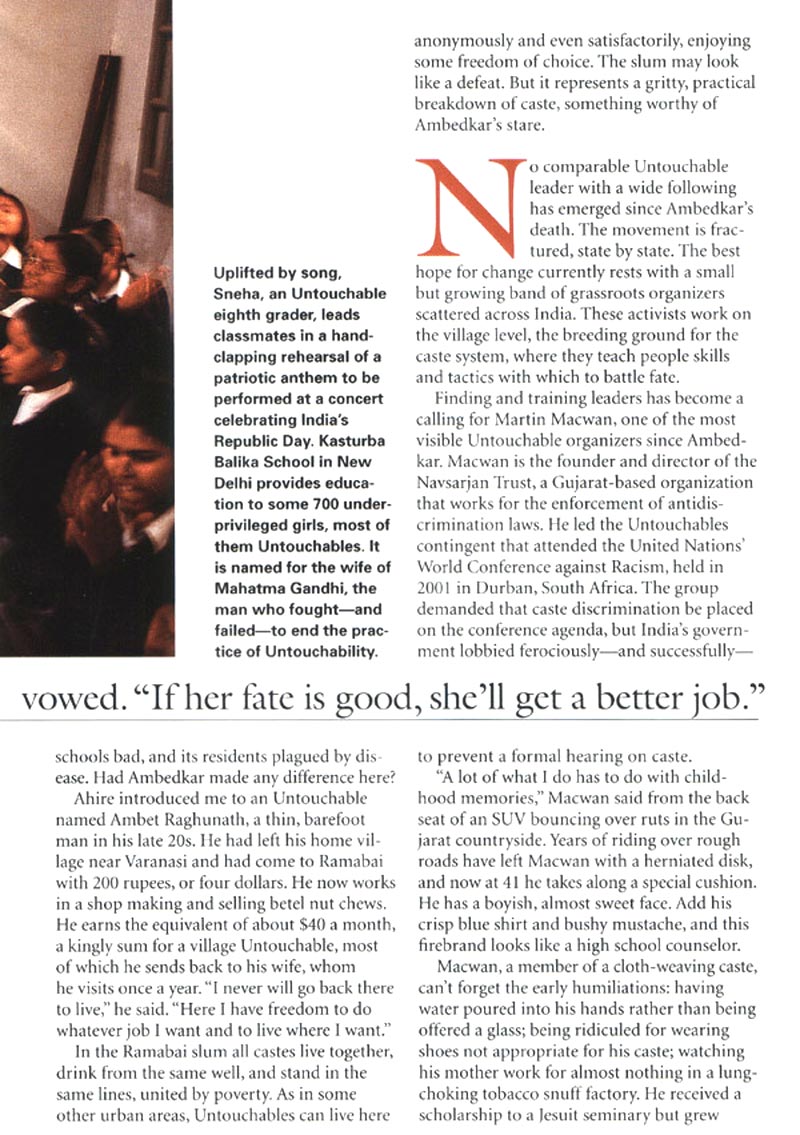
James 3:17 But the wisdom that is from above is first pure, then peaceable, gentle, willing to yield, full of mercy and good fruits, without partiality and without hypocrisy.
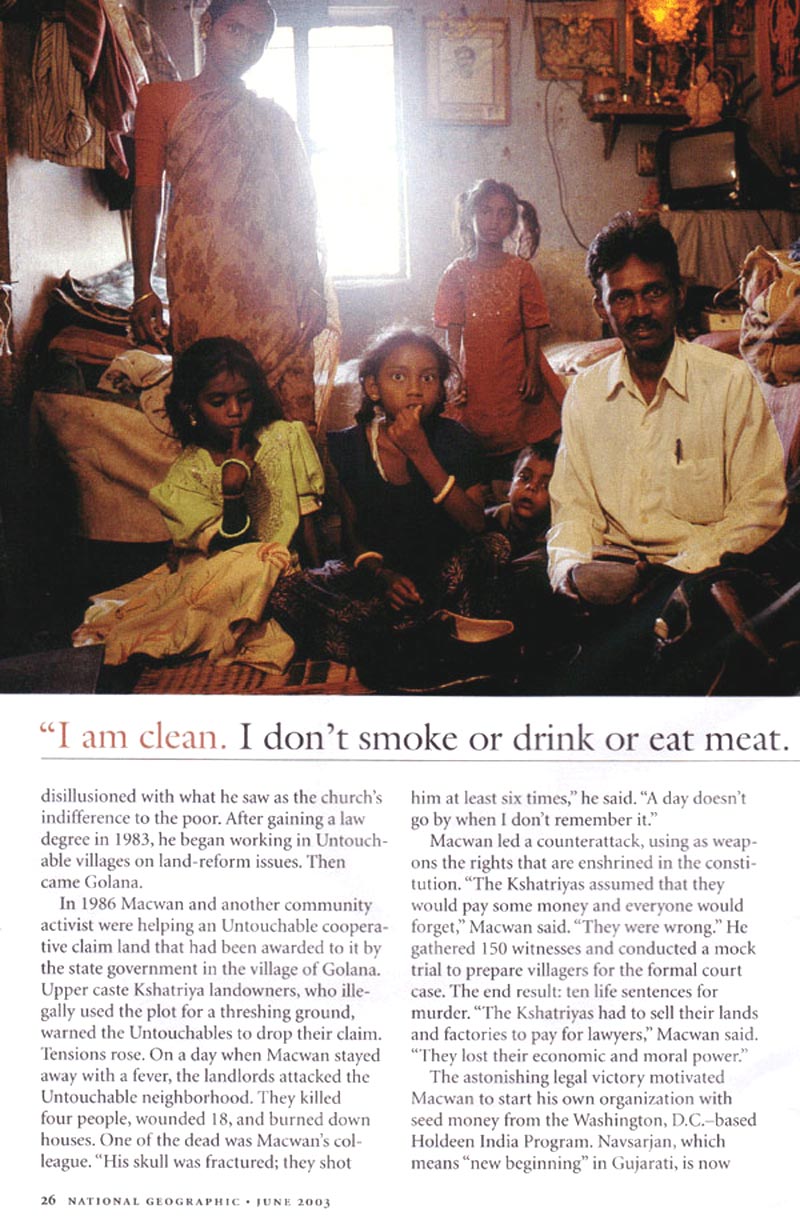
1 Peter 1:17-19 And if you call on the Father, who without partiality judges according to each one's work, conduct yourselves throughout the time of your stay here in fear; knowing that you were not redeemed with corruptible things, like silver or gold, from your aimless conduct received by tradition from your fathers, but with the precious blood of Christ, as of a lamb without blemish and without spot.
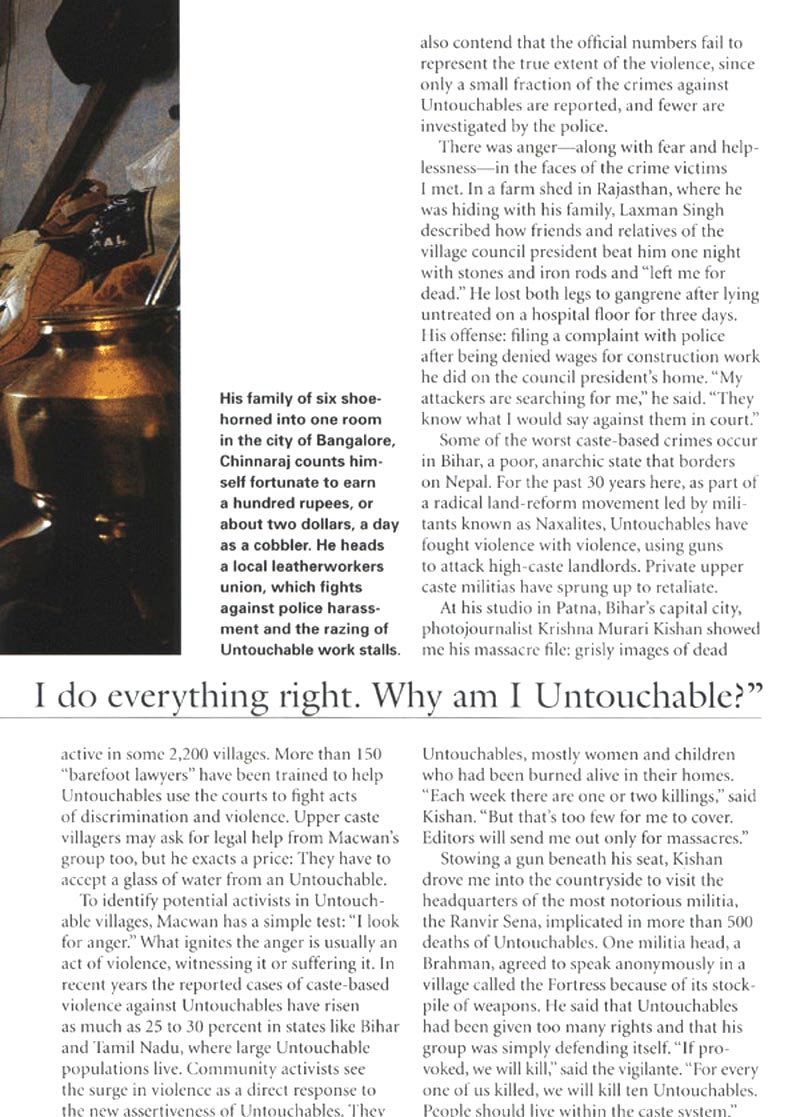
Galatians 3:28 There is neither Jew nor Greek, there is neither slave nor free, there is neither male nor female; for you are all one in Christ Jesus.
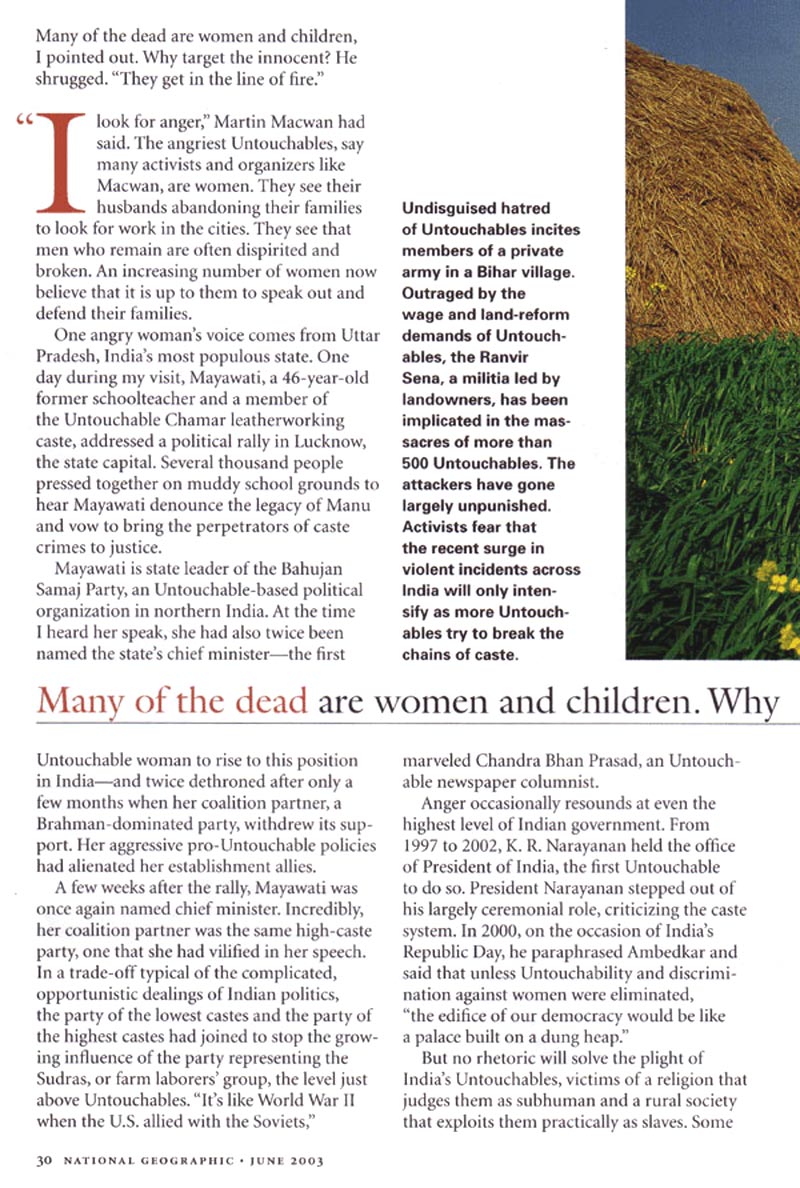
2 Corinthians 10:12 For we (Christians) dare not class ourselves or compare ourselves with those who commend themselves. But they, measuring themselves by themselves, and comparing themselves among themselves, are not wise.
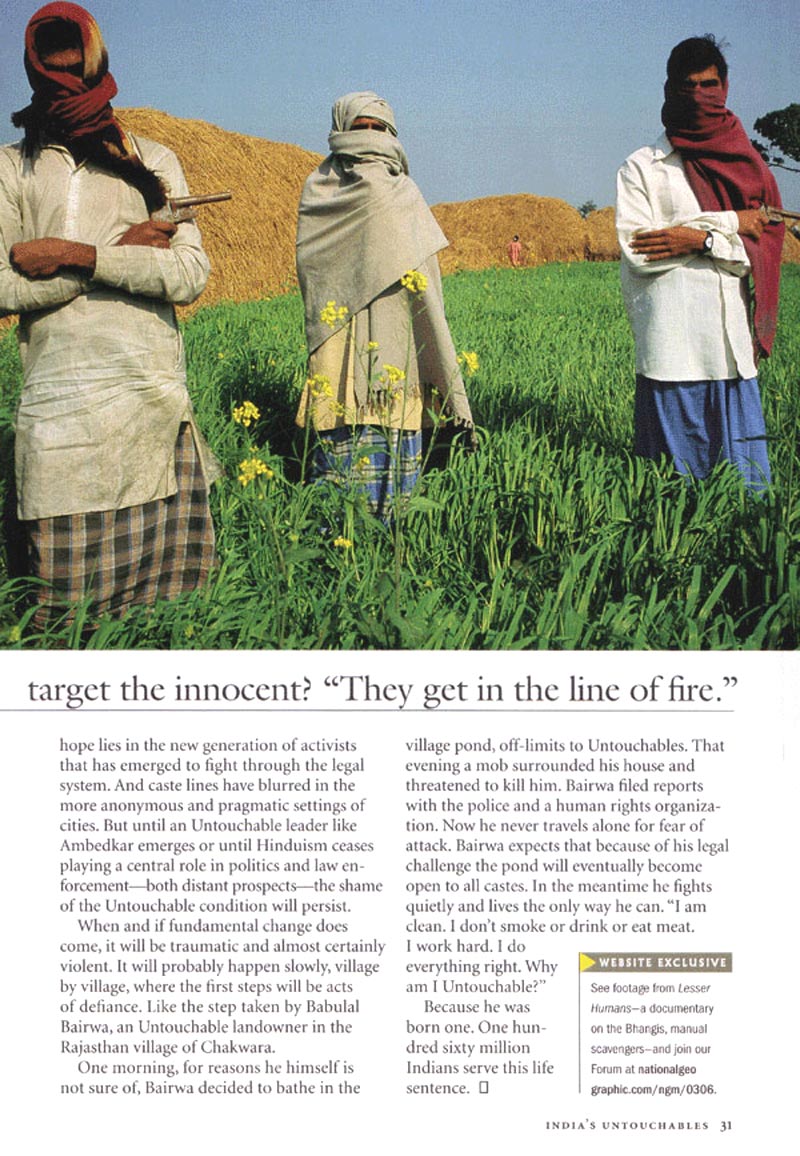
John 3:16 "For God so loved the world that He gave His only begotten Son, that whoever believes in Him should not perish but have everlasting life."
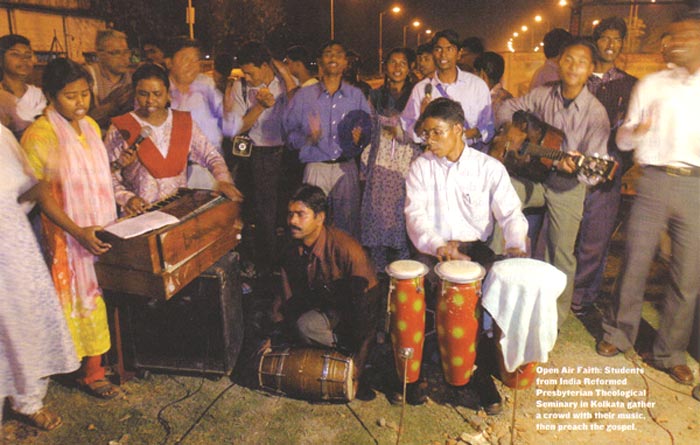
Is Christ Visiting India's Oppressed Untouchables?
Ed Vitagliano
Agape Press
For many Christians, the good news of the Gospel began with the words of St. John, or some other New Testament book. But for many of the most oppressed people of India, the Gospel often begins in Genesis, where they hear for the first time that they were created in the image of God.
That's because for the 250 million oppressed Dalits in that nation, Hinduism has taught them that they are subhuman and rejected by God.
According to Joseph D'Souza, president of the All India Christian Council (AICC), one of the largest interdenominational alliances of Christians dealing with national and human rights issues, the Dalits want out of Hinduism. That presents to Christians in India and around the world a historic opportunity to present Jesus Christ to a people thirsting for spiritual freedom - and the sociopolitical freedom that often comes with it.
Hindu Bondage
D'Souza, an Indian Christian and author of Dalit Freedom - Now and Forever, told AFA Journal that India's oppressive society is the direct result of the teachings of Hinduism, a 3,000-year-old faith and the nation's majority religion.
As D'Souza explains in Dalit Freedom, the Hindu faith recognizes millions of gods. However, there are three main gods: Brahma, Vishnu and Shiva, with the former being the first and chief of the three.
According to Hinduism, he said, God created man unequally. People are innately divided into four groups, called "castes." The Brahmins, or priestly caste, represent the head of God; the Kshatriya, or warrior caste, represent the shoulders and arms of the Divine; the Vaishya, or business caste, represent God's belly/thighs; while the Sudra, the "supportive workers serving the upper three castes," represent the legs and feet.
The first three castes form 15 percent of the Hindu population. "They are pure, they have all rights within the Hindu caste system," D'Souza said. "All religious, all economic, all spiritual rights."
The servant caste makes up nearly 50 percent. "That is the worker class - the people behind India's industrialization, the guys who pull the rickshaws, the guys who work in the fields, the farmers, etc.," he said.
Less Than Human
Outside the caste system - that is, the "outcastes" - are the Dalits. They are not even included in this picture of God, D'Souza said. Considered by Hinduism as unclean - they are known as "Untouchables" - the Dalits are not connected to God. They are less then human beings, even lower in status than animals, and they don't have a soul. They are 25 percent of the population.
This status as essentially little more than the refuse of God is the result of an ideology that has existed for three millennia. It is so deeply rooted in Indian culture that its tendrils have trapped the Dalits in a dark oppression rarely seen in human history.
"Dalits accepted their fate, believing they had done unspeakable acts in previous lives, that God did not love them, that they were born to serve the upper castes, and that they had no rights," D'Souza said.
As seems inherent in the fallen nature of mankind, those with power have used this ideology to exploit and oppress the Dalits. They cannot own land. They are forced to do the jobs no one else will do, such as clean toilets, sweep the streets and pick up dead animals. For the most part they are illiterate, since children are usually pulled out of school and sold into the job market. They are denied electricity and the use of public wells, and are frequently denied access to public places.
The Dalit plight under Hindu oppression has led to horrific abuses, according to Smita Narula, researcher for the Asian Division of Human Rights Watch, in her book Broken People: Caste Violence Against India's Untouchables.
"Thousands of untouchable female children [between six and eight years old] are forced to become maidens of God .... They are taken from their families, never to see them again," she said. "They are later raped by the temple priest and finally auctioned secretly into prostitution and ultimately die from AIDS."
According to estimates by the United Nations, Narula said "that 5,000 to 15,000 girls are auctioned secretly every year."
Dalit girls who escape this fate grow up to be Dalit women who also face abuse. "Making women eat human defecation, parading them naked, gang rapes, these are women-specific crimes," Narula said. "Gang rapes are mostly of Dalit women."
It is no wonder, then, that even the name itself, "Dalit," expresses the despair that these Indian people feel. It is a name the Dalits have given to themselves, D'Souza said, and it means "broken," "crushed," and "smashed beyond repair."
"It is a word that describes what has been their state for 3,000 years," he said.
A Spiritual Slavery
Technically, the Constitution of India bans the discrimination underlying the concept of "Untouchability," but D'Souza said there are two weaknesses in the attempt to find a political fix for the oppression of the Dalit people.
First, the Constitution does not outlaw the caste system, making it possible for the ideology to keep its roots in Indian culture. "The caste system is so deeply ingrained in the Indian cultural worldview through thousands of years of reinforcement that these attempts at granting equality have been largely ineffective," he said.
Moreover, where the law does address caste-based discrimination, D'Souza said penalties for violations are "enforced rarely because those responsible for enforcing the law are often the upper castes who are themselves biased by caste."
As oppressive as the culture is, however, the Dalits seem to realize that it is the Hindu faith that has enslaved them. Dalit scholars and speakers, D'Souza said, have recognized that India's poverty problem "is a spiritual issue, and this needs spiritual answers. Because what we have is a dark spiritual ideology that has been imposed upon and has gripped millions of people."
And the Dalits want out. A half century ago, Dr. B.R. Ambedkar, whom D'Souza described as the Dalits' "Martin Luther," declared: "I was born a Hindu, but I'm not going to die a Hindu."
Because of this systematic discrimination, D'Souza said, "the silent exodus of the Dalits from the [Hindu] social order continues unabated. It is critical to understand that this is an exodus of revolt against an evil and sinful structure. Those who are 'sinned against' are freely and willingly striking back at their oppressors spiritually and socially."
But Where to Go?
A half century ago, the Christian church in India had an opportunity to open its doors and offer the Dalits a place of refuge. Ambedkar himself considered both Christianity and Buddhism as alternative faiths, before settling on the latter.
Sadly, D'Souza relates in Dalit Freedom, it was because the church had itself embraced the caste system that Ambedkar decided on Buddhism. "Ambedkar recognized the fact that Jesus stood out against the caste system. However, he also saw that Indian Christianity had been poisoned by caste-based oppression," D'Souza said. "He could not accept the fragmented Church which was riddled with its own form of caste-based politics."
This was, D'Souza realized, unacceptable. "Caste discrimination within the Church was a shame and stigma to the life and message of Jesus," he said. "It was a betrayal of Jesus' mission itself."
It is a mistake that D'Souza and other Indian Christians refuse to make again. As he told the Indian media following a rally by Christians in support of the Dalit quest for emancipation: "It is our moral duty to stand by the Dalits. If the Church says only one thing, that Jesus Christ loves them, it's the message the Dalit community most needs to hear. They have been told for 3,000 years that God doesn't love them!"
Hindu Extremists Strike Back
The Christian support for Dalit freedom has not gone uncontested, however. Violence committed by Hindu extremists against Christians is growing, including beatings, kidnappings, rapes and murder. Crimes against property are also common, such as the destruction of churches, Christian schools and cemeteries, according to the British Broadcasting Corporation.
Perhaps the most publicized incident occurred in 1999, when Australian missionary Graham Staines and his two sons, ages eight and 10, were brutally murdered.
Staines, who had worked among Indian lepers for 34 years, had been working with local Christians, which resulted in vocal opposition from Hindus. One night following a religious service, as Staines and his boys slept in their Jeep, a Hindu mob burned down the village church, and then poured gasoline on Staines' vehicle and set it ablaze. The mob kept the three Christians from escaping, and beat back other villagers who attempted to rescue the missionary and his sons. (Staines' wife and daughter were in another town.)
D'Souza said Hindu extremists have been trying to instill "violent fear into the heart and mind of the Church. They want the Church to shut its doors to the oppressed millions who seek holistic liberation and salvation."
But, he added, this time the Church will not fail the Dalits. "In the goodness and mercy of God, we have seen in the last 10 years, God visiting the Dalit people. We have seen God delivering sovereignly, spiritually from heaven, the Dalit people. And across the nation they are meeting God in a variety of ways, and they are turning to Christ," D'Souza said. "So the process of breaking this spiritual darkness has begun."
Amnesty International Testimony
October 6, 2005
India’s Unfinished Agenda:
Equality and Justice for 200 Million Victims of the Caste System
Before the Subcommittee on
Africa, Human Rights and International Operations Committee on International
Relations United States House of Representatives By T. Kumar Advocacy Director
for Asia & Pacific Amnesty International USA
Thank you Mr. Chairman, and distinguished members of this committee. Amnesty International is pleased to testify at this hearing. We are here today to discuss a great injustice, an injustice based on discrimination not on the sole basis of colour, or gender, but on the basis of descent. In India today, nearly 200 million people known as dalits, (also known as “untouchables,” or “scheduled castes,”) are faced with socioeconomic discrimination, abuse, torture, and even death simply because of the family into which they were born.
This arrangement has been called India’s “hidden apartheid”, and rightfully so, for despite specific legal provisions against such discrimination in the Indian constitution and subsequent laws, intense persecution remains. The groundwork exists for India to institute lasting and substantive change. The Indian government should take meaningful steps to enforce existing legislation, and to explore other avenues of addressing this sad situation. The United States, as one of India’s trading partners and allies, must encourage India to take firm action.
Who Are Dalits?
India's caste system involves a social hierarchy and is often understood to be a feature of Hinduism. Individuals are considered to be born into a particular caste and remain in that caste throughout their lives. Broad caste categories (varnas) separate caste groups according to occupation (although mobility between occupations does not lead to changes in caste identity). Outside these caste categories are the "untouchables", now commonly known as dalits whose occupations -- sweepers, tanners, sanitation workers, etc -- were viewed as "polluting" the community.
Untouchability of dalits continues to be practiced in India in many forms, reinforcing an iniquitous social hierarchy and allowing for the continuing disempowerment and humiliation of millions of people.
How are Dalits Discriminated Against?
Localities housing dalits are often segregated from those housing non-dalits, a segregation which often extends to the provision of separate wells, eating places and temples and restrictions on the use of land to defecate. Many are agricultural laborers -- estimates suggest that at least two thirds of the bonded laborers in India are dalits -- while dalit women, and often children, dominate certain spheres of work, such as civic sanitation, scavenging and leatherwork (including the flaying and tanning of carcasses).
In most parts of the country, dalits have a proportionately small share in agricultural landholding, despite the allocation of government land. Dalits also do not have proper access to schools which accounts for high illiteracy rates and serves as a basis for increased discrimination. Additionally, dalits are routinely subjected to beatings, mutilation, murder, rape, and destruction of property by members of the upper-castes and the police, a culture of impunity ensures that most of the perpetrators go unpunished.
Abuses Committed Against Dalits
Abuses against dalits are numerous and take many different forms, they include (but are not limited to):
· Socioeconomic discrimination
· Beatings, slashings, and other forms of torture
· Arson – the burning of dalit communities
· Violence against women
o Rape, gang rape, and the parading of women through the streets naked
§ As a form of punishment
§ As the right of the upper-caste male
§ To punish or embarrass the woman’s family
o Beating and torture of women
· Summary execution, many times by burning alive
· Bonded labor
· Denial of rights, especially land rights
· Police abuses against dalits, custodial abuse
Efforts to address Abuses against Dalits
Article 17 of the Constitution of India states that the practice of "untouchability" is abolished and forbidden. Despite this prohibition, "untouchability" continues to be practised in India in many forms. Additionally, lower caste groups are ensured reservations in political bodies as well as public sector employment. Various other protective mechanisms have been put in place by the state to ensure rights for dalits. Legislation to criminalize abuses against Scheduled Castes and Scheduled Tribes began with the 1955 Protection of Civil Rights Act.
This Act was enhanced by the enactment of the Scheduled Castes and Scheduled Tribes (Prevention of Atrocities) Act in 1989 and Rules of 1995 which extended the scope of abuses which were criminalized and provided for graver penalties. Within the latter Act there are penalties for police acting negligently. Other extant legislation includes protection of the land rights of scheduled castes as well as legislation outlawing traditional abusive practices including "manual scavenging" (the manual disposal of human waste by dalits). However, most of these measures are not enforced.
Amnesty International’s Concerns
Amnesty International recognizes the huge challenge that the socio-economic situation in India presents for the state and the country as a whole. However with legislation designed to safeguard the rights of dalits in existence, and with constitutional guarantees for the abolition of ''untouchability'' and prohibition of discrimination on the basis of caste, Amnesty International believes the Government of India must respond to abuses against dalits with a powerful message -- not just through rhetoric but in practice -- that those who strive for equality will not be punished but that the state will find ways of supporting their initiatives.
Amnesty International is especially concerned about the following: police action, denial of justice, impunity, torture, violence against women, persecution of human rights defenders, dalits under sentence of death, and violence against pro-dalit and dalit activists.
Police: A Solution or a Problem?
Amnesty International believes that the current policing structure encourages discrimination by allowing police to act at the behest of particular powerful groups rather than to act lawfully in the interests of society as a whole and by encouraging arrest on the basis of suspicion rather than on investigation and evidence. In practice also, the failure to prosecute many unlawful activities of the police and the problems of victims in accessing justice mean that discriminatory practices are perpetuated.
The prevalence of political interference in policing by powerful individuals and groups, ensures that the most socially and economically weak members of society are most vulnerable to abuses including torture and ill-treatment by police at the behest of those groups. Victims have nowhere to turn but to the police to enforce laws designed to end discrimination. But the police are not equipped or willing to do so. It is an enduring problem which can no longer be overlooked.
Hurdles to Dalits Seeking Justice
In practice, there are numerous hurdles to dalits seeking justice. Section 21 of the Scheduled Castes/Scheduled Tribes (Prevention of Atrocities) Act imposes positive duties on state and central governments to ensure proper implementation of the Act. These include the provision of legal aid and travel expenses for witnesses and victims attending trials. It states that many offences are "non-bailable" and do not allow for anticipatory bail, therefore protecting victims from possible reprisals. However, the reality has been very different. In many cases cognizance is not taken of abuses. When cases are reported they are often not filed under the Act as police are under pressure from the perpetrators who are aware of the graver penalties for offences under the Act.
Furthermore, dalit activists are frequently charged under the National Security Act, the Indian Explosives Act and sections of the Indian Penal Code. There have also been several cases of police harassment of NGO activists, ranging from periodic police visits, to arrest and charges of aiding and abetting in various crimes or interfering in police investigations. These findings were borne out in discussions which Amnesty International held with human rights defenders during 1999.
Impunity: An Example
Gaje Singh, a 39-year-old tailor and member
of the dalit
community in Nayagaon, Ropar District, was allegedly assaulted by police on
October 17, 2001. Several officers of the 37 Battalion of the national Central
Reserve Police Force (CRPF) attacked the village in reprisal after an officer
was allegedly beaten up by Gaje Singh and his neighbors in a personal dispute
over the money charged for some work. After meeting resistance, CRPF officers in
uniform and armed with service weapons returned to the village at about 8pm,
ransacked several shops and beat Gaje Singh with iron rods, rifle butts and
sticks. A handicapped shopkeeper, Darshan Singh, and his 78-year-old mother,
Satpal Kaur, were also beaten with iron rods. Gaje Singh suffered serious
injuries to his head, chest and feet. Darshan Singhs right arm was broken and
his mother suffered injuries to her back. Three officers of the regular police
who were in the vicinity did not intervene during the attack, nor did any police
officer help the injured.
Gaje Singh filed a complaint at Nayagaon police station and the Punjab police
registered a criminal case for minor offences against four CRPF officers.
However, no arrests were made. To initiate criminal prosecution against officers
of a central security force, permission from the Union government needs to be
obtained, but Punjab Police did not take any steps to seek such permission. A
senior CRPF officer assured a lawyers organization monitoring the case that
disciplinary action would be taken against the officers and that they would be
asked to pay the victims medical expenses. He also suspended three of the
officers involved in the attack and acknowledged that it was a blatant case of
"police highhandedness". Police officers subsequently tried to convince the
victims to settle the matter out of court by offering them some money, but the
offer was reportedly not accepted. No formal charges were brought against the
officers concerned and the fate of the disciplinary action initiated by the CRPF
is unknown. The victims are finding it difficult to obtain the money needed to
take their complaint further to the Punjab Human Rights Commission and are under
pressure from other villagers to drop legal proceedings.
Torture and Violent Abuse
Amnesty International is concerned that dalits are particularly vulnerable to torture and ill-treatment and that there is evidence of discrimination within the police system. Cruel, inhuman or degrading treatment sometimes amounting to torture is particularly common in this context. Physical and verbal abuse and intimidation of individuals by police on the basis of their caste, ethnicity, religion or gender is commonplace not only for detainees but also for those who visit the police station to make a complaint.
Amnesty International is also aware of many incidents in which police have reportedly beaten members of the dalit community, including women, following requests by members of upper caste communities that they be punished. Dalit women are particularly vulnerable to sexual torture by law enforcement officials, often as a means of punishing male relatives or "teaching their community a lesson". The failure of police to register complaints of violence against dalits or adivasis (tribal groups) or to pursue investigations under legislation specially designed to protect members of these groups -- the Scheduled Castes and Scheduled Tribes Prevention of Atrocities Act, 1989 -- has also been well documented.
Torture and abuse against dalits by upper-caste members are also extremely common. For example, in May 1999 it was reported that a young widow named Chunni was tied to a tree and brutally beaten on the orders of the panchayat (local village council, which included seven women) for failing to prevent the deaths of livestock in Amara village of Banda district in Uttar Pradesh. She was reportedly hung upside down, her genitals stuffed with chili powder and thrashed with lathis (batons). She died of her injuries. Villagers told police she had committed suicide. All 13 panchayat members were arrested and charged with murder.
In another incident, an elderly dalit man recalled how his wife, daughter and two sons were burned alive, along with three others, when members of a dominant Hindu upper caste set fire to three huts belonging to dalit families. His eldest son, the first graduate from the village, also had been murdered two years earlier by caste Hindus. All the dalits dalit woman is raped every sixty hours and a dalit is murdered every nine days. in the village had fled and none wanted to return home as they believed the police would not protect them. Examples of this nature abound, it is estimated that a
Violence Against Dalit Women: A Double Discrimination
Amnesty International saw evidence of the intersection of gender inequality and other forms of discrimination throughout its visit to areas of Uttar Pradesh and Rajasthan. The concept of gender equality continues to be alien to many communities and many state institutions particularly at the local level. In the areas of Uttar Pradesh and Rajasthan visited, caste and land rights are crucial factors which impact on political, social and economic relationships.
In Uttar Pradesh political parties representing dalit and lower-caste communities have played a role in recent years in empowering some of these groups in certain areas. While it is difficult to generalize about a situation in which caste groups and relationships between them are extremely complex, groups such as dalits, adivasis "backward castes" and others continue to be most socially and economically vulnerable as a result of lack of access to land ownership and meaningful political participation.
Estimates suggest that at least two thirds of the bonded laborers in India are dalits and that over half the dalit workforce are landless agricultural laborers. Sixty-six per cent of all women agricultural laborers are dalits earning between Rs.8-25 [$0.17-0.54] per day.
Placed within the context of both gender and caste discrimination, more often than not inhabiting rural areas of severe impoverishment, dalit women become an easy target for exploitation and violence. Given that women embody the concept of honor, violence against women becomes a symbolic gesture of exploitation and discrimination within dalit communities. Thus, sexual harassment by landowners, moneylenders and their hired thugs is common.
Rape, gang rape, parading of women through the streets naked, and beatings are common actions taken against women and girls by both the police and members of the upper-castes. Reasons for these practices vary from using violent means of punishment, to viewing sexual relations with dalit women as their caste right, to using sexual torture as a means of embarrassing and punishing the woman’s family.
Violence Against Dalit Women: A Case Study
Violence against women is also connected to many different issues of caste relations such as land rights. The story of Ram Chandra and his wife, Ramvathi, perfectly illustrates this fact. Ram Chandra, a dalit living in Munni Khera was married to Ramvathi and they owned a piece of land on which they had a house. Upper caste villagers were trying to take the land from them and Ram Chandra and Ramvathi had objected to this.
In September 1998, Ramvathi was gang-raped by five men. Higher caste villagers are believed to have raped her as a means of isolating her and her husband within the village and the dalit community because of the stigma attached to rape and to punish them for refusing to give up their land.
After the rape, Ram Chandra went to the Hassanganj police station to lodge a complaint. However, police refused to lodge a First Information Report (FIR). There are allegations that police took money from one of the accused. The couple were constantly threatened by influential people in the village and their house was attacked. Ram Chandra finally made an application to the Superintendent of Police of Unnao district concerning the rape and the failure of the police to lodge an FIR. However, despite the Superintendent of Police ordering that the incident should be investigated (no action was taken against police for refusing to lodge an FIR) local police again managed to ensure that the incident was not investigated. Finally under severe pressure, the couple moved to Ramvathi's parent's village some distance away.
They returned to the village on January 30, 1999, reportedly determined to reclaim their property. They were met by three men, who were soon joined by others, armed with sticks and axes. Ram Chandra sent his wife to the house, fearing violence. He was then beaten by around 17 men with sticks. His left leg and left hand were broken. When he started screaming, Ramvathi and several other women came to find out what was happening. Ram Chandra described what happened next:
"They attacked my wife with stick, she fell down then and there. After that my wife came to me and laid over my body to save me, then they had beaten my wife with sticks and axes. She got deep injuries on the head and shoulder and her right hand and leg broken. [one of the attackers] put off all the clothes of my wife, raped her and inserted and pushed the stick in her private part".
The attackers left Ramvathi for dead and ran away. Ram Chandra and his wife were taken to the district hospital where Ramvathi died the next morning.
When, on the next day, activists approached the Superintendent of Police about the incident, which had been reported in the media, he reportedly denied that the incident had occurred and said that the media had exaggerated the facts. Activists went to the village to investigate but villagers were too scared to speak about it. They found Ramvathi's husband in the district hospital. He could only move his neck because he had been beaten so badly. He had not even been told that his wife had died.
Finally, many women don't approach police for fear of dishonor or that they will be dismissed or further abused. An activist working with dalit women in Uttar Pradesh estimated that only 5% of cases of violence against women are registered. Many dalits are not aware of their rights under special legislation designed to protect them, and it is rare for police to voluntarily inform them.
Persecution of Human Rights Defenders
Human rights defenders from outside areas where caste-based abuses have occurred who attempt to highlight those abuses and put pressure on the authorities to take remedial action are sometimes themselves made the subject of harassment by the state. This has reportedly included banishment from particular areas under Section 10 of the Scheduled Castes and Scheduled Tribes (Prevention of Atrocities) Act, 1989 which provides for ''removal of person likely to commit offence''.
Amnesty International is concerned at apparent attempts by the state to limit the work of human rights defenders in internationalizing the issue of discrimination against dalits. The Government of India has explicitly stated that the issue of caste discrimination does not fall within the remit of the International Convention on the Elimination of All Forms of Racial Discrimination which India ratified in 1968. At the hearing of India's report to the Committee on the Elimination of All Forms of Racial Discrimination in September 1996, the Committee explicitly affirmed that "the situation of the scheduled castes and scheduled tribes falls within the scope of the Convention" and expressed great concern that India had failed to reconsider its position on this (CERD/C/304/Add.13).
Dalits and the Death Penalty: An Example
Four dalit men were sentenced to death in 2002 in Bihar state. Their appeal was rejected in December that year, despite concerns that they had not received a fair trial. They were convicted in February 1992 for the killing of 35 members of an upper-caste armed group in Bihar state. They were convicted of a "terrorist act" under the now lapsed 1987 Terrorist and Disruptive Activities (Prevention) Act (TADA Act), which gave police sweeping powers to arrest and detain without trial under the Act’s vague and imprecise provisions. It was used to arrest, among others, members of vulnerable groups. Amnesty International is concerned that the men's trial fell short of international fair trial standards.
Dalit Community Awareness and Activism
One positive development has been the increased social awareness and activism among dalit communities. A growing awareness of rights amongst these communities, demands for social and political equality and an unwillingness not only to allow such abusive practices to continue but to be a silent witness to the apathy of the administration, has led many dalits and others to take active steps to defend those rights.
However, the growing assertion of dalit human rights which necessarily challenges existing power groups, be it landlords, employers or even so-called "backward castes", has met with violent reaction in some quarters. In 1998, the Times of India reported that the annual report of the National Commission for Scheduled Castes and Scheduled Tribes which was presented to the President had referred to frequent caste clashes erupting in Uttar Pradesh, Bihar and Tamil Nadu, stating "Whenever the Dalits have tried to organise themselves or assert their rights, there has been a backlash from the feudal lords resulting in mass killings of the Dalits, gang rapes, looting and arson" Times of India, (Times of India, February 10, 1998).
Conclusion
In conclusion, it is the responsibility of the Indian government to fully enact and apply its legal provisions against discrimination on the basis of caste and descent. It must take concrete action to reign in groups who discriminate against dalits, including the police. The culture of impunity must end, and the perpetrators must be brought to justice. Until India’s “hidden apartheid” is truly and completely abolished, the world’s largest democracy cannot hope to make truly substantive progress towards liberty for all.
Recommendations
Amnesty International calls on the United States government to:
1. Encourage India to adopt the recommendations outlined above and use every opportunity to raise the problem of caste discrimination and violence both publicly—at international meetings, congressional hearings, and in press conferences—and privately, at Consultative Group meetings and in meetings with relevant officials.
2. Encourage American owned business in India to establish a quota system, similar to the Indian government’s, which ensures the setting aside of jobs for qualified dalits, especially women.
3. U.S. government funded projects in India should also establish quotas to encourage the hiring dalit workers.
The U.S. government should instruct its officials at the World Bank and other similar institutions to ensure that funds allocated to projects in India are non-discriminatory and include a quota for dalits.
Amnesty International calls on the government of India to:
1. Take steps through public education and other means to ensure societal and attitudinal changes amongst the population towards the human rights of dalits. These should include incorporating changes in school curricula to create attitudes which would help combat violence against dalits and to guard against reinforcing caste stereotypes, and training teachers to ensure non-discriminatory approaches to education.
2. Adopt all appropriate measures, especially in the field of education, so as to instill values which will prevent caste-based violence and discrimination. These should include ensuring that schools provide a safe environment void of caste-based violence.
3. Place the elimination of caste-based violence on the agenda of Panchayats and other organs of government down to the lowest levels throughout the country. Ensure that knowledge of legal rights and various laws related to scheduled castes and scheduled tribes feature in any training program for newly elected Panchayat members as well as Sarpanches, Upsarpanches, Gram Sevaks and others and involve non-governmental organizations in such training.
4. Invite the Special Rapporteur on Torture to investigate patterns of violence against dalits.
5. Ensure implementation of the Scheduled Castes and Scheduled Tribes (Prevention of Atrocities) Act, 1989 and Rules of 1995 and take action against officials who have failed to implement the Act and its Rules.
6. Implement existing legal sanctions against police officers found responsible for illegal actions based on discrimination and initiate disciplinary action against police officers found to have acted in a discriminatory manner towards individuals.
7. All police stations should hold and display in regional languages copies of relevant legislation enacted to protect certain vulnerable groups from violence and abuse.
8. Incidents of torture and other human rights violations should be carefully monitored with a view to determining correlation of their occurrence with victims belonging to certain categories in society. Statistics should be published and steps taken to provide special protection on the basis of this information. Monitoring mechanisms should involve the statutory commissions established to protect particular groups in society as well as non-governmental bodies and individuals who come from or represent these groups in society.